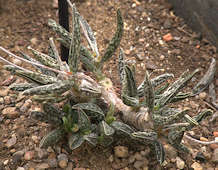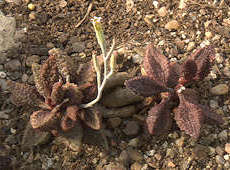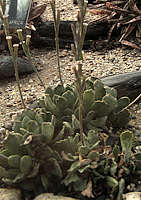Adromischus marianiae Berger 1930
This variable species is distributed over a considerable area of South Africa from the Western Cape to Namibia and includes several superficially dissimilar subspecies and varieties formerly regarded as separate species. Many varieties have attractively spotted or marked leaves. Some forms with warty or ridged leaves are considered especially desirable by collectors. The many forms of Adromischus marianiae could be the basis for a collection in their own right, yet would occupy a relatively small space as the plants are quite compact.
|
 |
 |
Adromischus marianiae var. immaculatus Uitewaal 1953
Syn: Adromischus marianiae antidorcatum von Poellnitz 1938
With age, this variety develops a pachycaul stem supporting tufts of lanceolate leaves blotched with purple. In full sun the leaves become reddened. Aerial roots are produced along the stems. Opinions differ as to the relative merits of mature vs. young plants, but personally I like the pachycaul appearance of old plants.
|
 |
Adromischus marianiae var. immaculatus Uitewaal 1953
Syn: Adromischus marianiae 'herrei' von Poellnitz 1938
This densely-branching plant has thickened roots and lanceolate to oblanceolate bronzed leaves with grooved, spotted or warty leaves. Individual leaves break off, root and grow freely so one tends to end up with a collection of small plants instead of a large specimen. Collectors' forms include variants with different degrees of wartiness and all-green leaves. Native to a limited area of the Western Cape around Maerpoort.
|



 Families of Succulent Plants
Families of Succulent Plants Crassulaceae
Crassulaceae 


